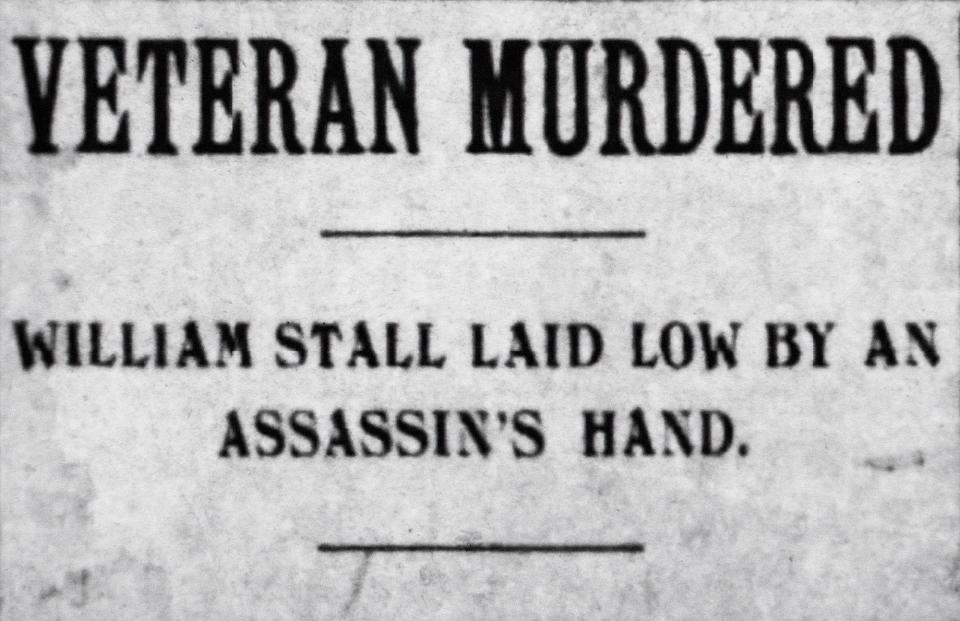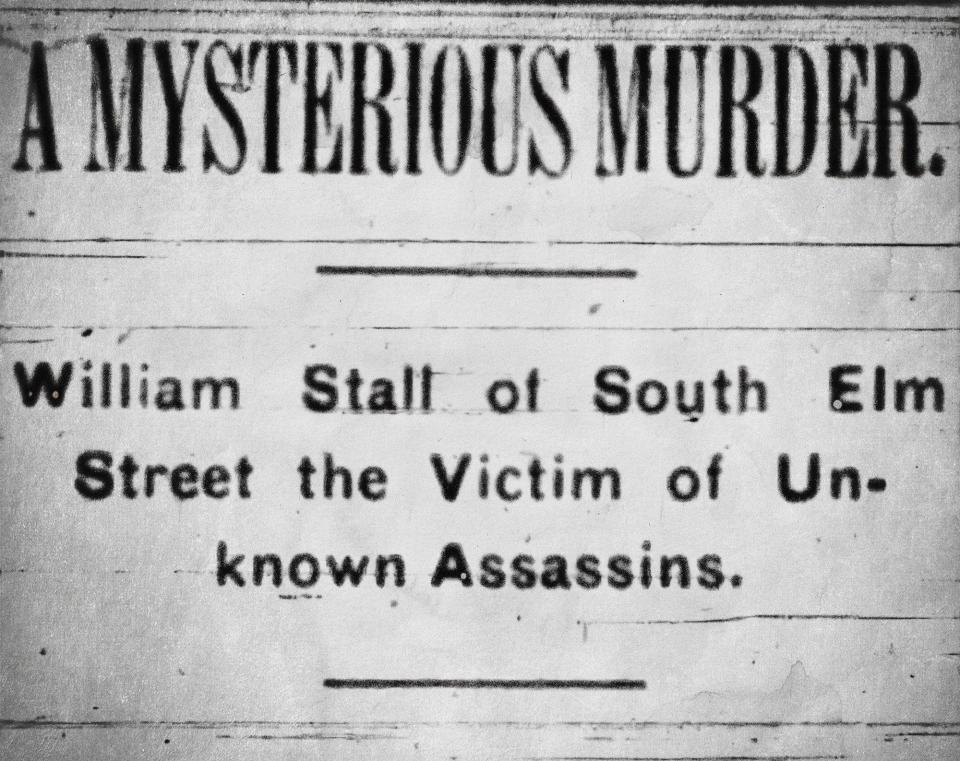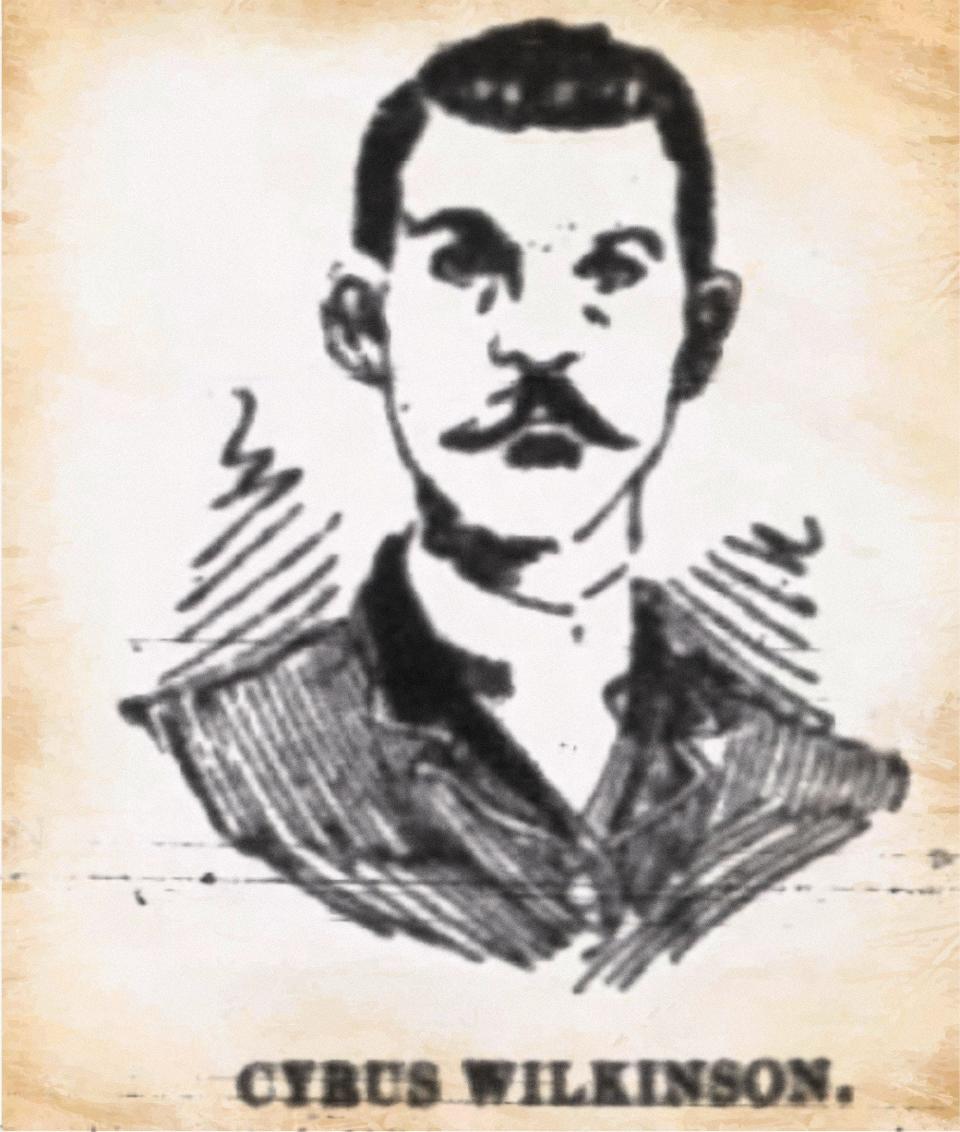ByGone Muncie: Who Killed William Stall?
MUNCIE, Ind. -- Around 6 a.m. on the morning of Sept. 5, 1898, Joseph Nelson and George Thornburg of Crystal Lake Ice Company were out making deliveries in what is now Muncie’s South Central Neighborhood. Steering their wagon around the corner onto Elm from Seventh, the ice haulers spotted a man lying awkwardly across a front walkway.

Up often before dawn, Nelson and Thornburg routinely stumbled across remnants of late night Munsonian debauchery. It was the 1890s after all; a liquor-sodden grown man sleeping off a stupor in a front yard wasn’t exactly a novel site in the Magic City. Nelson stopped the ice wagon in front of 1302 S. Elm where the man laid “on his face, with his legs crossed and one arm under him.” It was still too dark to see clearly, so Thornburg called out asking if everything was okay.
No response came.
Alarmed, the icemen hopped out of the wagon and walked toward the crumpled figure. They recognized immediately he was “cold in death.” Thornburg ran to Fifth Ward councilman Christian Hanika’s house on Eighth Street and phoned police.
Foul play suspected
A crowd formed by the time MPD patrolmen arrived. The corpse was identified as William Stall, the owner of the house. R. Meeks and Sons dispatched their ambulance and brought Stall’s body back to their morgue at 115 E. Main Street. Delaware County’s coroner Ulysses Poland suspected foul play and conducted a post-mortem inquest. He was assisted by local doctors Arthur Kemper and Isaac Trent.

The Daily Herald reported Stall “had been struck in the face and on the head with a blunt instrument, presumably a sand bag. There was no abrasion of the skin except a small piece which had been torn from over the left eye. A heavy blow had fallen there.” His skull was crushed in the attack, “causing internal bleeding.” He also had two large bruises on his chest, suggesting violent kicks to the heart after hitting the ground. It was clear that someone killed William Stall.
The victim lived at the Elm Street house with his wife Ardelia and the couple's three adult children, Sadie, Harry, and Minnie. Lindsey Plymale, Minnie’s husband, also lived in the home along with boarders Alex Jacobs and Curtis Deeter. The house was located in the Anthony Park Addition, one of several newish near-south side residential neighborhoods built during the gas boom.
'Man of ordinary talents'
William Stall lived a relatively unassuming life there with his family. He worked at Gill Clay Pot Company and, according to the Muncie Morning News, “has resided in Muncie more than ten years, having come from Greenville, Ohio.” He “was a man of ordinary habits, visiting saloons frequently, but seldom drank to excess.” His boss Frank Gill said “he was one of the most quiet men he had ever met.” More people knew about his brother John, the editor of the South Bend Times and a bigwig in state Democratic politics.
The Stalls had emigrated as children from Baden-Württemberg, Germany with their mother in 1853 and settled in Harrisburg, Pennsylvania. William fought for the Union during the Civil War, though he volunteered under the alias William Houser, using his stepfather’s surname. He served in the 127th Regiment of the Pennsylvania Infantry and was wounded in the Battle of Fredericksburg. Stall moved to Ohio post-war and married Ardelia Cox in 1869. Three children later, the family moved to Muncie where gas boom-era factory jobs were plentiful.
The evening before he died, William returned home from work and, as usual, gave Ardelia most of his week’s earnings, retaining only $1.25. He left around 7:00 pm, stopped for a quick shave, and made his way to Harry Webster’s Saloon at the corner of Walnut and Ninth streets. He drank a few beers and kept score for a card game he played with Charles Hines, Thomas Hatton, D.T. Johnson, J. Painter, and Cy Wilkinson.
Stall left around 11 p.m. with Hines and walked north on Walnut toward home. Just before midnight, Stall bade his friend goodnight and turned east down Eighth Street. Hines later remarked that Stall had “evidently seen something before he started up the alley, which startled him. He seemed to be in a much greater hurry.”
A quarter past midnight, William Krutchman heard two men fighting nearby on Elm Street while dropping a friend off a few blocks away. Unable to see the commotion clearly, he turned and took another route. Around the same time, Arthur Ault, a delivery driver for Hickman Brothers Grocery, noted the silhouette of a man standing in front of Stall’s house and someone else lying in a hammock out back.
William’s 22-year-old son Harry occupied the hammock, having slept outdoors that night. He told police he heard two men arguing in front after midnight. The Stall’s boarder Alex Jacobs heard the fight from inside the house, which woke him up around the same time. Jacobs could distinguish only the words “liar” and “home.” Both paid the shouting no nevermind, accustomed as they were to “men fighting and wrangling along the streets at all hours of the night.”
A gold watch and $1.05
Robbery was ruled out as a motive, as Stall’s body retained a gold watch and $1.05. A break in the case came when Noah Vern, Ardelia’s nephew and a clerk at Mock’s Second Hand Store, told police that Cy Wilkinson recently sought out his advice, believing he probably “would be arrested for the crime.”
Apparently that was enough to persuade the police in 1898 and Wilkinson was arrested on suspicion of murder. MPD captain Curtis Turner along with patrolmen James Cole, Hamilton Beall, John Gallagher, and William Vickery ran Wilkinson “through the ‘sweat box’ for an hour” on the night of Sept. 13.

The cops were also likely acting on a rumor. Stall had once accused Wilkinson of sleeping with one of his daughters, or as the Morning News put it, he “was on too intimate terms with Miss Stall.” Wilkinson had stayed as a boarder with the family some time back.
Wilkinson emphatically denied murdering anyone and reiterated that he never slept with Minnie or Sadie. He also denied speaking with Vern and claimed to be on friendly terms with Stall, though he noted “we were not so friendly as before he made the accusation.” Wilkinson pointed to the pleasant card game the evening before the murder. In the end, there was no actual evidence to hold Wilkinson and he was released the next morning.
Coroner Poland concluded that Stall “died from the effects of a blow on the forehead on the night of September 3, 1898; said blow having been administered by an unknown hand.” The case was never solved.
Chris Flook is a Delaware County Historical Society board member and a Senior Lecturer of Media at Ball State University.
This article originally appeared on Lafayette Journal & Courier: ByGone Muncie: Who Killed William Stall?

